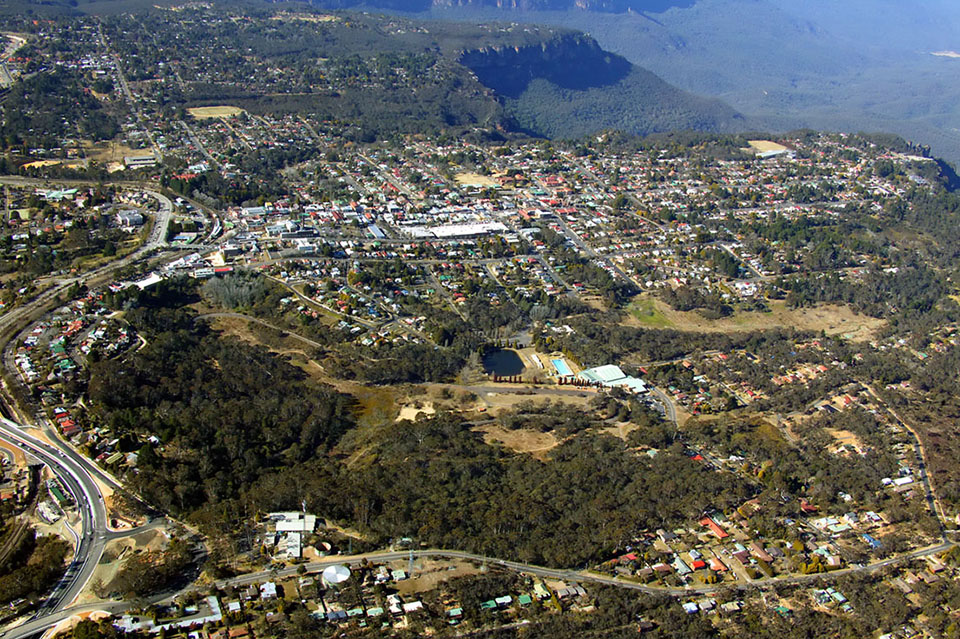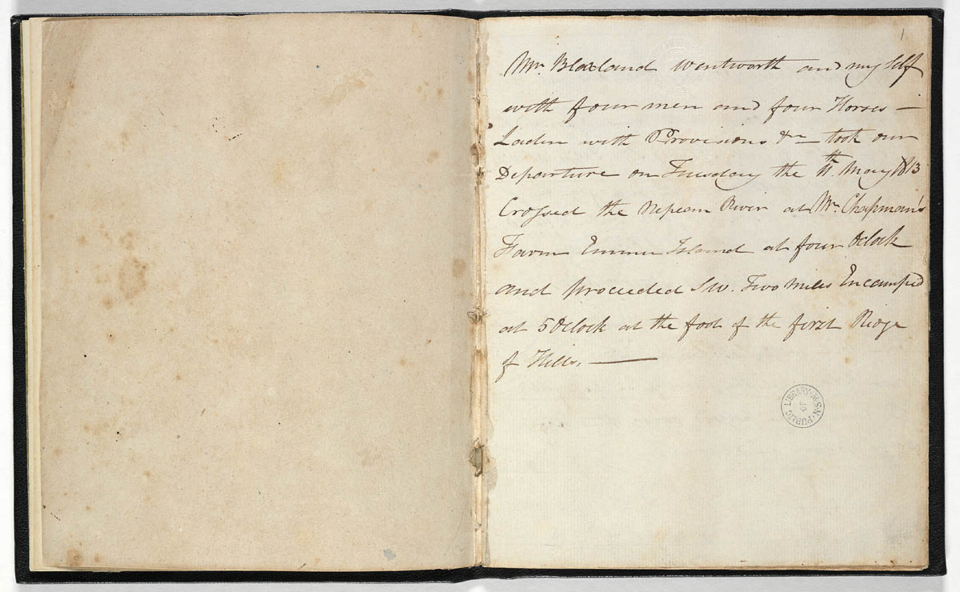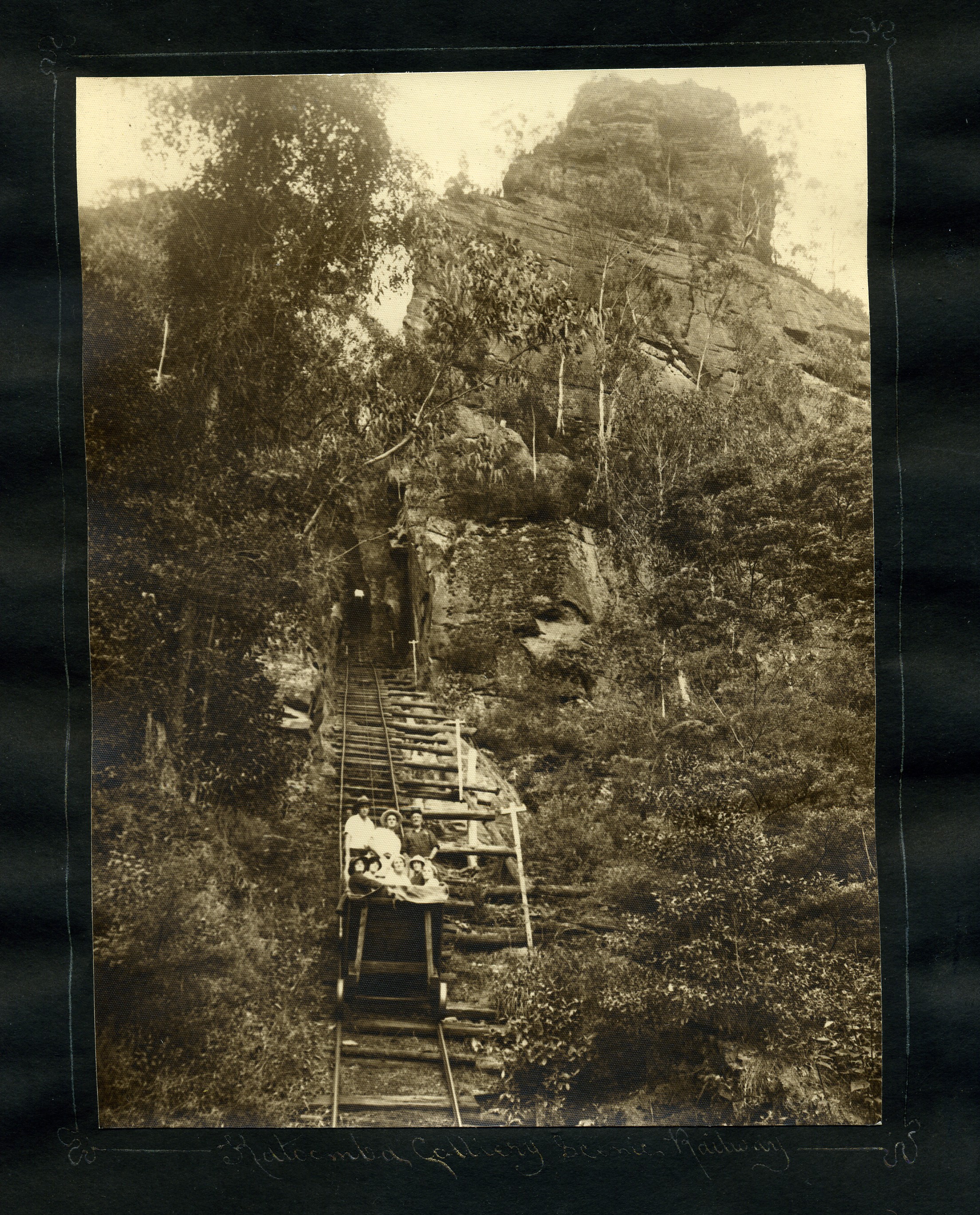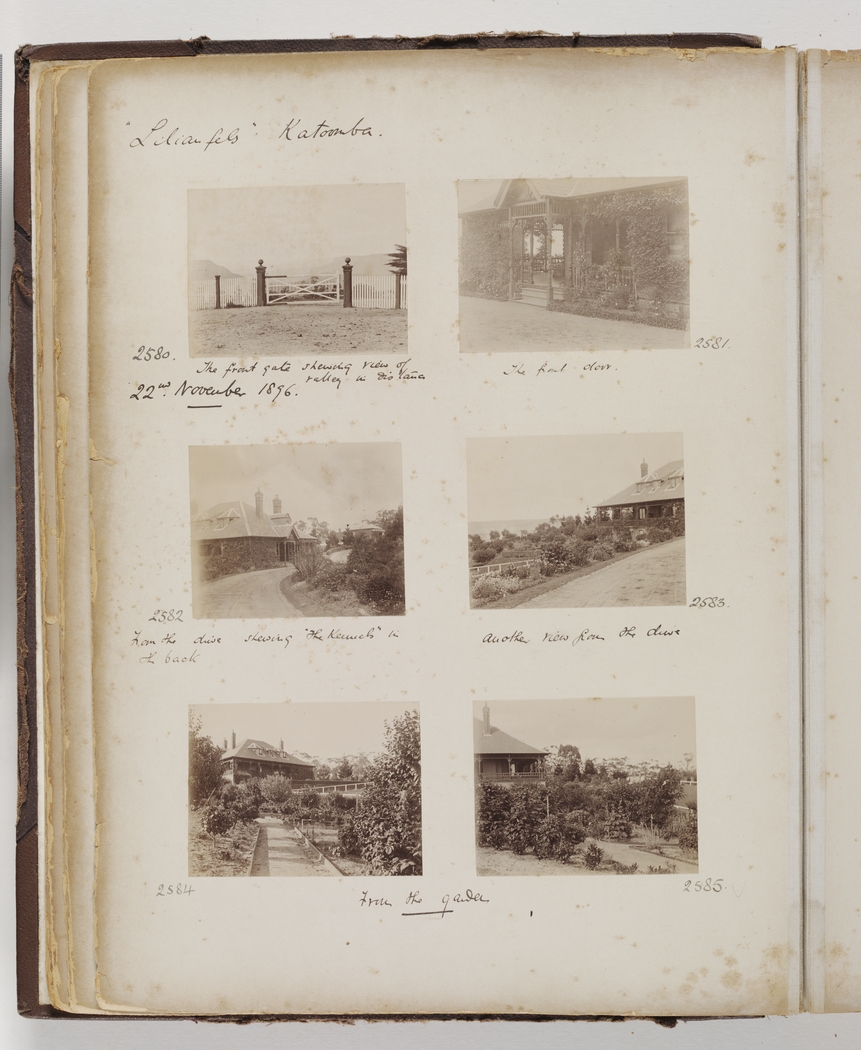The Dictionary of Sydney was archived in 2021.
Katoomba
Citation
Persistent URL for this entry
To cite this entry in text
To cite this entry in a Wikipedia footnote citation
To cite this entry as a Wikipedia External link
Katoomba
[media]Katoomba is one of the largest towns in the Blue Mountains, and is located between Leura and Medlow Bath, 110 kilometres west of Sydney, at an altitude of 1,017 metres. The upper Blue Mountains, including Katoomba, is the traditional land of the Gundungurra people and intermittent Indigenous habitation of the upper mountains dates from around 22,000 years ago.
Early days
[media]The western road from Penrith to Bathurst, opened in 1815, passed close to the area of Katoomba and followed the route opened by the explorers Gregory Blaxland, William Charles Wentworth and William Lawson in May 1813. Early coachmen's names given to the locality include William's Chimney and Collett's Swamp. As through traffic on the road increased the locality became a stock resting place and from the mid-1830s, the Shepherd & His Flock Inn, also known as Blind Paddy's, operated near Pulpit Hill, on the western edge of present-day Katoomba. Here the diarist Louisa Anne Meredith met with bed bugs and dined on 'the never failing dish of ham and eggs, chops, damper, tea' and spent 'a tolerable night's rest with no worse nocturnal visitants than a moderate party of the universal light infantry', on her journey to Bathurst in 1839.
In its early years Katoomba laid no claim to the importance it later achieved among the mountain towns. Following the completion of the railway line to Mt Victoria in May 1868, the area was known as The Crushers, which was the name of the railway platform and nearby quarry established to supply rail track ballast. Trains from the west found The Crushers a convenient place to stop and adjust their loads before the steep descent to Penrith. The present railway station replaced an earlier timber platform and station building erected in 1881.
Katoomba emerges
Towards the end of the 1870s this lonely mountain outpost began to change dramatically. The official name change to Katoomba occurred in 1878. The story goes that while on a picnic with Harry Peckman, a local cabbie, raconteur and driver to the gentry, James Henry Neale who was the local member of parliament took a local Kanimbla Aboriginal woman, known to Europeans as Black Bet or Princess Betsy, to the top of Katoomba Falls overlooking the Jamison Valley and asked her what the place was called. She answered 'ka-toom-bah', translated as 'place of many waterfalls'. Recent research now suggests that this is the name for the edible blechnum fern root that was an important Aboriginal plant staple collected from the Blue Mountains valleys.
Mining the mountains
[media]1878 was also the year that businessman John Britty North opened his coal mine at the base of the cliffs near Katoomba Falls. Within a year the high quality of his coal was winning prizes at the Sydney International Exhibition and the small settlement of Katoomba was gaining a reputation as an important mining centre.
From 1895, the shale mining activities at the Ruined Castle and Glen Shale Mines gradually decreased. The seams were becoming exhausted and the returns from sales were reduced. By 1903, the shale industry at Katoomba ceased to exist. Most of the equipment was transferred to the Australian Kerosene Oil and Mineral Company's operation at Tarbane. The lease at West Katoomba expired in 1906.
In 1925 there occurred a revival of North's long abandoned coalmine below the cliffs at South Katoomba. A local syndicate formed the Katoomba Colliery Ltd and resumed mining activities on a lease of 160 acres. The old workings supplied a substantial quantity of coal, which was sold on the local market, principally to the Katoomba Electric Power House and in smaller amounts to the hotels, guesthouses and local residents.
[media]During the 1930s Depression however, capital costs increased and the local market was reduced. Despite its decreasing viability, the mine continued to operate until World War II. However as the company progressed toward liquidation, one aspect of its operation had a parallel rise in fortune, and helped to augment the mine's declining income. The rehabilitation work carried out on the coal haulage system up the cliff face opposite Orphan Rock integrated into the booming Katoomba tourist industry of the 1920s and 1930s, and the 'Mountain Devil' of the early 1930s eventually became the Scenic Railway of today.
Country houses and holidays
[media]While North was developing his mining enterprise, the leaders of Sydney society also began casting their eyes in the direction of Katoomba. The 1870s had seen the growing popularity of Springwood and Mount Wilson as locations for country retreats. The 1880s and 1890s saw the beginnings of an era of hotels and guest houses in Katoomba and the upper mountains. Shops, schools and a local newspaper appeared and in 1889 the town was gazetted as a municipality.
The first council, elected in January 1890, governed a socially divided community: at one extreme a roaring mining camp with slab and weatherboard cottages and hotels, cable ways and horse drawn tramways stretching out into the Megalong and Jamieson valleys, and at the other, a fashionable and wealthy resort hotel high on the hill of Katoomba Street. Together the settlement comprised about 100 buildings.
The visitors of the 1880s and 1890s were primarily from the privileged classes who saw in Katoomba, at just over 1,000 metres above sea level, something resembling an Indian hill station. They stayed in gracious comfort at stylish establishments like The Great Western Hotel, later renamed The Carrington, The Leura Coffee Palace, later The Ritz and The Balmoral. They sought the mysteries of nature among the cool fern walks and glens; they had money and leisure and Katoomba not only offered a retreat from the summer heat and dirt of the city, but also from the pressures of the political and business world of Sydney. Travellers on the Western Road availed themselves of more modest establishments such as George Biles's hotel, now the Hotel Gearin, first licensed in 1881.
Business and development
The town's main thoroughfare, Katoomba Street, was named around 1882 and is today the principle street of the township. The earliest business centre however developed on Main Street, originally the Bathurst Road, in the area of The Balmoral and The Burlington guest houses. The Town Hall and Council Chamber were sited at the top of Park Street near the present fire station. A still largely intact streetscape follows Main Street to the intersection at the top of Katoomba Street opposite the railway station.
Froma House was built on the hillside below the Carrington site by James Neale, in about 1867. Froma House was probably the first dwelling of any permanence, apart from the railway gatehouse, built in the central area of Katoomba. Neale, a butcher by trade, and his brother Thomas, acquired a 400-acre (162-hectare) portion of land running from The Crushers down to Echo Point, covering much of the area of central Katoomba, for £1 an acre in 1875, land which included several waterfalls. Neale was interested in bush walking and developed many of the scenic tracks and reserves around Katoomba, all radiating from Froma House. Neale Street, named before 1882, follows his original meandering track south to Katoomba Falls.
Around 1878 he disposed of most of the land then known as the Katoomba Estate to the consortium which built the Great Western Hotel. Its opening in 1882 marked the emergence of Katoomba as more than a mining town. In 1886 the hotel was sold by the widow of the original owner, Harry Rowell, to FC Goyder, a squatter from Queensland and first mayor of Katoomba. He improved its facilities, added wings to double the accommodation and obtained the patronage of the then Governor, Lord Carrington, in whose honour it was renamed.
Neale died in 1890 at Wentworth Falls and was given a Methodist funeral. In 1883 Froma was bought by Michael Metcalf (1813–1890), a merchant, customs agent and prominent Sydney Anglican, whose family lived there until 1911. By 1914 old Froma had gone, replaced by a kindergarten school of six rooms close behind the new post office which had recently been erected in rapidly developing Katoomba Street. Froma Lane was established as a right of way to connect Park and Katoomba streets and was described in the Blue Mountains Echo of 29 August 1913 as
a very crooked alley that follows the tortuous plotting of the various allotments and contains the postmaster's residence.
This building is now called Froma Court.
In 1905 AL Peacock leased the Carrington from Goyder and advertised it as 'the largest and best known tourist hotel in the Southern Hemisphere'. Peacock also served as an alderman on council and in 1907 was instrumental in bringing a town water supply and sewerage service to Katoomba; coincidentally this also allowed the Carrington to advertise 'a splendid service of lavatories, baths and water closets upon each floor'.
By 1913 the wealthy newspaper magnate and colourful racing identity James Joynton Smith had gained control of the Carrington. Smith built the power station at the rear of the building with its famous tapering octagonal brick chimney and contracted to supply power to Katoomba and the upper mountains until council built its own power station in 1925. In its long heyday under Smith the hotel earned significance for the glamour, wealth and political influence of its guests. It has dominated Katoomba for over a century and is now a rare example of a Victorian resort hotel with its gardens in a town setting.
Changes in tourism
By the end of the nineteenth century, economic and social changes were occurring in the wider Australian community which began to produce a more affluent and mobile middle class. Visitors whose preference was less palatial accommodation arrived and the patronage of the rich and famous moved elsewhere. Lord Carrington, for example, moved his entourage to the southern highlands. As the war clouds began to gather in Europe, Katoomba was entering its boom period and in the interwar optimism of the 1920s there were over 60 guesthouses operating in the town.
The motor car also revolutionised tourist activity and tourist coach firms flourished, with some guest houses even maintaining their own fleet. To the holiday-makers and honeymooners who flocked there during the 1920s and 1930s, Katoomba was the holiday capital of the state. They spent the days touring the sights in charabancs and putting roses in their cheeks in the bracing mountain air, and in the evenings danced, roller-skated and attended the latest moving pictures.
World War II saw a jump in building applications for cheap cottages to escape the perceived threat to Sydney and local bushmen were recruited to form a resistance movement in the event of invasion. Many of the hotels and guesthouses were commandeered by the armed forces for the use of Australian and allied soldiers recovering from wounds or for rest and recreation.
[media]After World War II, Katoomba became increasingly urbanised as its affordable cottages and building blocks attracted first home owners and young families. Many of their breadwinners joined the long distance train commute to the city. On early morning trains known by names such as the Fish and the Chips, the aroma of breakfast kippers, eggs and bacon cooked on a kerosene stove in a carriage compartment was a regular event; less so following electrification of the line in 1957.
Its affordability and its natural charms also made Katoomba a popular place for people escaping the nine-to-five work regime through pursuing the creative life. Varuna, the family home of long-term Katoomba resident and novelist Eleanor Dark, is now a retreat for writers, while the list of residents who describe themselves as poets, writers and publishers is lengthy.
By the 1960s and 1970s day trippers travelling by car or bus replaced the long stay tourists. With tourism the only industry, the local economy suffered as lower cost overseas travel become possible and the popularity of the coast drew visitors away. The arrival of supermarkets forced many of the old-style shop keepers out of business, to be replaced by coffee shops, galleries and souvenir shops. The old hotels and guest houses gradually lost patronage and many fell into disrepair. Some were demolished, others were converted to nursing homes and hostels and a few remain. Yet despite these changes, the economic and other benefits of preserving the extensive original building fabric of Katoomba have finally been acknowledged and much of the old Katoomba survives, in its main street, its colourful characters from the past and its famous resort hotel.
References
Croft & Associates in association with Meredith Walker, Blue Mountains Heritage Study, Final Report, Department of Environment and Planning and the Blue Mountains City Council, Katoomba NSW, 1982
J Low, Pictorial Memories: Blue Mountains, Atrand, Crows Nest NSW, 1991
Louisa Meredith, 'A Lady's Journey to Bathurst in 1839', Notes and Sketches of New South Wales 1839–1844, John Murray, London, 1844
John Merriman, Katoomba Walking Tour, Blue Mountains City Library, Springwood NSW, 2005








